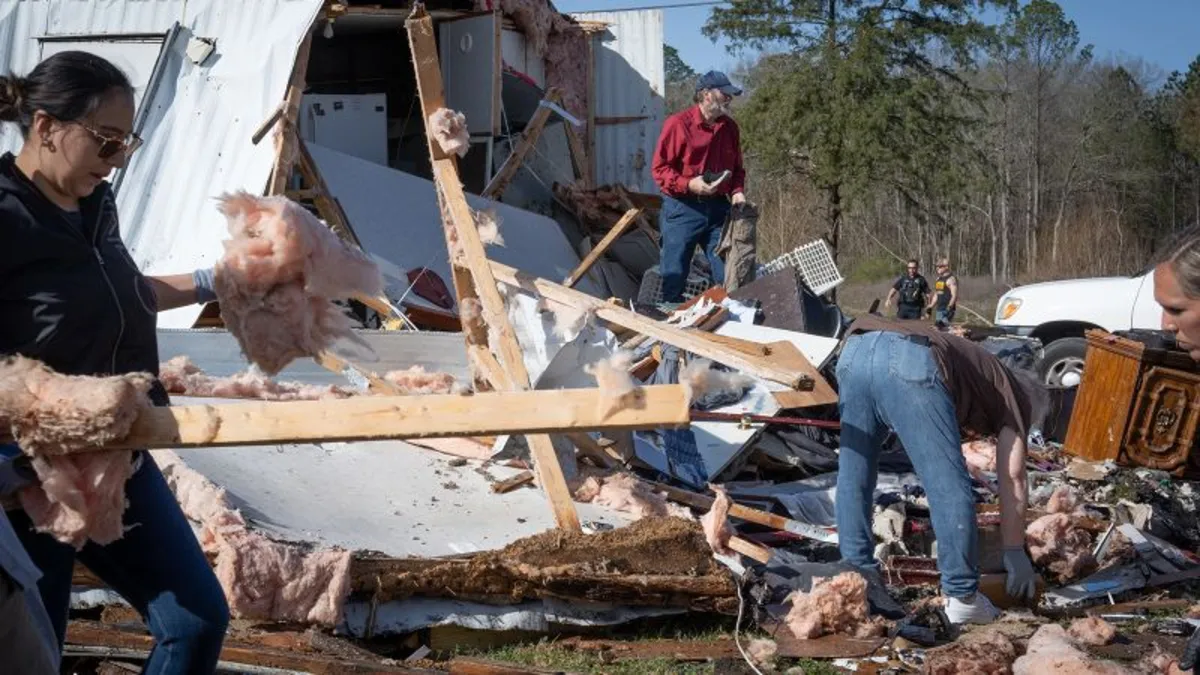
A powerful storm system that recently swept across the United States is set to move offshore into the Atlantic on Monday. However, the aftermath has left a trail of devastation in its wake, impacting communities across several states with violent tornadoes, wildfires, and dust storms. According to officials, at least 39 people have died in storm-related incidents spanning seven states, with Missouri bearing the highest death toll of 12 fatalities, followed by Kansas with eight confirmed deaths. Alabama has also reported at least three fatalities, with many residents describing the scene as a “disaster.”
“I’ve seen nothing like this since I was a kid,” said one resident from Alabama when asked about the destruction. The recent storms prompted widespread concern regarding the nation's ability to respond to severe weather and natural disasters, especially in light of recent layoffs at the National Oceanic and Atmospheric Administration (NOAA) and potential cuts to the Federal Emergency Management Agency (FEMA).
The remnants of the storm are expected to move offshore from the Mid-Atlantic early Monday and will clear the Northeast by the end of the day. Fortunately, the rain and storms in the Northeast are not anticipated to be severe. Over the weekend, the storm unleashed a deadly wave of tornadoes across the Central and Southern US, with approximately 80 tornado reports—dozens of which have been confirmed. The National Weather Service indicated that two EF4 tornadoes struck Arkansas on Friday, marking a significant event as it is the first time in over 25 years that Arkansas has experienced multiple EF4 tornadoes in a single day.
One of these EF4 tornadoes, with winds reaching 170 mph, affected areas near Larkin, while another caused destruction in the town of Diaz with estimated wind speeds of 190 mph. Tornadoes classified as EF4 are categorized as “violent” and can lead to catastrophic damage, including the complete destruction of homes, tossing vehicles, and uprooting large trees. The storms have resulted in at least three fatalities in Arkansas alone.
In Alabama, three deaths have been reported in Plantersville, Dallas County, and Winterboro, Talladega County, as damage assessments continue across more than half of the state’s counties. Governor Kay Ivey stated, “Yesterday’s severe weather impacted most of Alabama,” offering condolences to the affected communities. The high winds exacerbated the devastation, leading to over 710 windstorm reports across central and eastern states. These storms and the accompanying fierce winds resulted in power outages for hundreds of thousands of homes and businesses over the weekend, as documented by PowerOutage.us.
As cleanup begins in the South and East, the Southern Plains face ongoing fire weather threats. Numerous wildfires emerged on Friday afternoon in these regions, prompting critical fire weather alerts, or level 2 of 3 from the Storm Prediction Center, across parts of western Texas, Oklahoma, southwestern Kansas, eastern New Mexico, and southeastern Colorado on Monday. An elevated fire weather risk is also in effect from southeastern Arizona to central Texas, extending northward to South Dakota.
Warnings indicate that “extremely critical conditions” may arise across eastern New Mexico into the Texas Panhandle, potentially spreading into western and central Oklahoma on Tuesday afternoon. Fuels in these regions have undergone extreme fire weather conditions recently, making them highly susceptible to rapid fire spread. Red flag warnings are in place for over 20 million people from New Mexico to Missouri, with gusts reaching 60 mph and extremely dry air present.
Cleanup efforts commenced on Sunday in Alpine, Alabama, where volunteers from Revive Church were left shocked by the destruction. James Stewart, a volunteer, described the scene as a “disaster,” stating, “I’ve seen a few tornadoes in my lifetime, a couple of hurricanes. But other than that, this is pretty bad.” The damage included a school gymnasium reduced to ruins and a school bus overturned against the building, with debris scattered throughout the area.
Brandon Chittam, another volunteer, noted that about two dozen people were assisting in the cleanup. “It’s a wreck, but it’s coming together real quick,” he remarked, emphasizing the collaborative effort of the community. Pastor Charles Kelly observed the stark contrast between the minimal damage sustained by his church and the catastrophic destruction nearby, expressing hope for community resilience. “You’re going to see people at their best in the days ahead,” he stated, highlighting the importance of community solidarity.
The recent storm has raised alarms regarding the preparedness of federal agencies to respond to such disasters. The Trump administration’s focus on reforming or even eliminating FEMA, along with significant layoffs at NOAA, has left many experts and lawmakers concerned about the agencies’ ability to provide timely and effective disaster response. Recent reports indicate that as many as 800 employees have been let go at NOAA, raising questions about the agency's capacity to deliver critical weather alerts in the future.
As the nation grapples with the aftermath of these devastating tornadoes and severe storms, President Trump announced that his administration stands ready to assist the affected regions. The focus now shifts to recovery and ensuring that communities have the support they need to rebuild and recover from this unprecedented weather event.